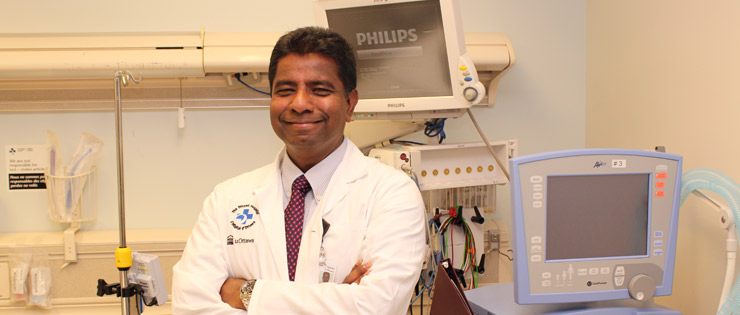
Emergency physician Dr. Venkatesh Thiruganasambandamoorthy was right beside one of his family members when she fainted a few years ago. This experience, paired with seeing fainting patients in the emergency department, inspired his research into better ways to screen and care for this population.
Dr. Venkatesh Thiruganasambandamoorthy was getting ready for bed when one of his family members called to him from the bathroom. The 37-year-old woman had been under the weather for most of the day and now she was feeling sick to her stomach.
She said, “I think I am going to go,” and then fainted.
As an emergency physician at The Ottawa Hospital and assistant professor at the University of Ottawa, Dr. Thiruganasambandamoorthy deals with fainting patients all the time. Usually, it’s the body’s reaction to hot or crowed environments, intense emotion or pain. It’s generally not a serious health problem.
But when after three or four minutes he couldn’t feel her pulse, he was worried enough to call an ambulance.
“I really thought she might be dead,” he said.
When the paramedics arrived soon after, Dr. Thiruganasambandamoorthy was relieved to learn that her heartbeat was normal. A few minutes later, she woke up and was fine.
For the doctor, it was a reminder of how unsettling fainting can be for patients and their loved ones.
“If it’s scary for me, imagine what it’s like for people who don’t have the knowledge I do,” he said. “It really takes a toll, especially on the families.”
Fainting is fairly common: 35 to 40 percent of people will faint at least once in their lives. Most of the time it’s harmless, but for a small number of patients it can be a symptom of a potentially life-threating condition like arrhythmia, or heart rhythm disturbance.
Dr. Thiruganasambandamoorthy hopes a new nine-step tool developed by his research team will help physicians identify which fainting patients are at risk of these conditions. The tool is currently being verified in emergency departments.
“The way fainting patients are examined in emergency rooms varies greatly,” said Dr. Thiruganasambandamoorthy. “We hope that this screening tool will make the process more consistent. Also, if our tool can discharge low-risk patients quickly and safely, then I think we can reduce emergency room wait times and open up those resources to other patients.”

Support patient care and research at
The Ottawa Hospital


 To reset, hold the Ctrl key, then press 0.
To reset, hold the Ctrl key, then press 0.